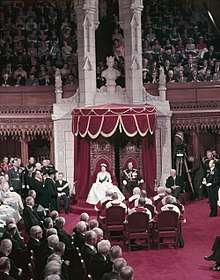Casual wear
.jpg)
| Part of a series on |
| Western dress codes and corresponding attires |
|---|
 |
|
Supplementary
|
|
Legend: |
Casual attire or casual wear, clothing is a Western dress code category that comprises anything not approporiate with formal attire, semi-formal attire, or informal attire dress codes. In general, casual attire is associated with emphasising personal comfort and individuality over formality or conformity. As such, this type of dress may also be referred to as leisurewear. The word "casual" can in a broader sense be defined as something relaxed, occasional, spontaneous, or "informal" in the sense of "not formal" or "suited for everyday use" (although notably informal attire actually refers to a dress code more formal than casual attire, a step below semi-formal attire).[1] Yet, when indicated as a dress code for instance on an invitation, casual attire may still be expected to be done tastefully, meaning that trousers and shirts do not have holes, tears, or stains. [2]
Because of its wide variety of interpretations per definition, casual attire may be defined not by what it is by rather what is not:
- Formal attire such as morning dress and white tie (dress coat), but also ceremonial dress variants, military full dress uniform, religious clothing and folk costume
- Semi-formal attire such as stroller and black tie (tuxedo)
- Informal attire, including business professional wear comprising suits, ties waistcoats and dress shoes[3]
Notably, however, dress codes within casual attire category such as business casual, smart casual or dress clothes may indicate expectation of some sartorial effort, including suit jacket, dress trousers, closely resembling the result of informal attire.
Elements
Sport coat, Blazer, Jeans, Dress Shirt, Casual Collared Shirt, and a T-shirt describe to be a casual wear for men.[4][5] With the popularity of spectator sports in the late 20th century, a good deal of athletic gear has influenced casual wear, such as Adidas suits, running shoes, and track clothing. Clothing worn for manual labor also falls into casual wear. Basic materials used for casual wear include denim, cotton, jersey, polyester, flannel, and fleece. Materials such as velvet, chiffon, and brocade could be considered too fancy for casual wear.[6]
While utilitarian costume comes to mind first for casual dress, however, there is also a wide range of flamboyance and theatricality. Punk clothes and fashion of the 1970s and 1980s is a striking example. Madonna introduced a great deal of lace, jewelry, and cosmetics into casual wear during the 1980s. More recently, hip hop fashion has played up elaborate jewelry and luxurious materials worn in conjunction with athletic gear and the clothing of manual labor.
Casual wear is typically the dress code in which new forms of gender expression are attempted before being accepted into semi-casual or semi-formal situations. An obvious example is masculine jewelry, which was once considered shocking or titillating even in casual circles, and is now hardly noteworthy in semi-formal situations. Amelia Bloomer introduced trousers (of a sort) for women as a casual alternative to formal hoops and skirts. In a recent mirror image, sarongs and other skirts have been embraced by a few men of the European tradition as a casual alternative to formal trousers. Both of these innovations caused great embarrassment in formal circles. The trend toward female exposure in the 20th century has also pushed the necklines of formal ball gowns ever lower and the skirts of cocktail dresses ever higher. For men, the exposure of shoulders, thighs, and backs is still limited to casual wear.
Gallery

 A U.S. artist wearing a casual minidress during a public interaction.
A U.S. artist wearing a casual minidress during a public interaction._(cropped).jpg) A woman wearing sports bra and boyshorts in Sydney.
A woman wearing sports bra and boyshorts in Sydney.
 A model in T-shirt and cargo shorts.
A model in T-shirt and cargo shorts. Model in jeans and a military-style shirt.
Model in jeans and a military-style shirt.
See also
References
- ↑ http://www.yourdictionary.com/casual
- ↑ Allan, Patrick. "What All of Those Confusing Dress Code Terms Really Mean". Lifehacker. Retrieved 2017-05-05.
- ↑ "Attire Guide: Dress Codes from Casual to White Tie - The Emily Post Institute". The Emily Post Institute, Inc. Retrieved 2017-05-05.
- ↑ https://www.artofmanliness.com/articles/sharp-casual-young-man-guide/
- ↑ https://www.realmenrealstyle.com/how-to-dress-sharper/
- ↑ https://www.namedclothing.com/material-chart/